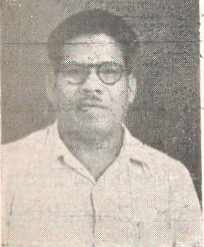The Pragati Legislature Party(Also called Pragati Dal) was a political grouping in the Legislative Assembly of the Indian state Orissa. PLP was formed in 1973 by the Utkal Congress, Swatantra Party and others. The PLP leader Biju Patnaik, was elected as the Leader of the Opposition of the Assembly on February 9, 1973. His tenure as Leader of Opposition lasted until March 3 the same year. On that date President's Rule was introduced in the state.

The Praja Socialist Party, abbreviated as PSP, was an Indian political party. It was founded in 1952 when the Socialist Party, led by Jayaprakash Narayan, Rambriksh Benipuri, Acharya Narendra Deva and Basawon Singh (Sinha), merged with the Kisan Mazdoor Praja Party led by J. B. Kripalani.

Sangeeta Kumari Singh Deo is an Indian politician and the wife of the titular Maharaja of Bolangir, an erstwhile princely state located in Odisha. She is the current Member of Parliament in the Lok Sabha from Bolangir of Odisha and member of the BJP. She is a member of the National executive of the party.
The politics of Odisha are part of India's federal parliamentary representative democracy, where the union government exercises sovereign rights. Certain powers are reserved to the states, including Odisha. The state has a multi-party system, in which the two main parties are the nationalist Bharatiya Janata Party (BJP) and the regional, socialist Biju Janata Dal (BJD). The Indian National Congress (INC) has also significant presence.

Bolangir Lok Sabha constituency is one of the 21 Lok Sabha (parliamentary) constituencies in Odisha state in eastern India.

Patna State was a princely state in the Eastern States Agency of India during the British Raj. It had its capital at Balangir. Its area was 6,503 km2 (2,511 sq mi).

Maharaja Sir Rajendra Narayan Singh Deo KCIE was an Indian politician and the last ruler of the princely state of Patna in Odisha before Indian independence in 1947. He was the President of the Ganatantra Parishad political party from 1950 to 1962 and the President of the Odisha state unit of the Swatantra Party after its merger with the Ganatantra Parishad in 1962. He was the Chief Minister of Orissa from 1967 to 1971.
Elections were held in March 1952 for the Bihar Legislative Assembly. There were 276 constituencies with 50 of them being two-member constituencies. The Indian National Congress (INC) stormed into power. Shri Krishna Singh became the first elected Chief Minister of Bihar and Dr. Anugrah Narayan Sinha became the first Deputy Chief Minister cum Finance Minister of the state.

Kishen Pattnaik was an Indian social leader, socialist thinker, author and activist. As a member of parliament for the 3rd Lok Sabha, he represented the Praja Socialist Party for the Sambalpur Constituency of India. Pattnaik founded and edited a Hindi monthly periodical called Samayik Varta.

Arkesh Singh Deo is an Indian politician from Odisha and a leader of the Biju Janata Dal political party. Arkesh Singh Deo is the youngest son of previous Bolangir MLA Ananga Udaya Singh Deo and grandson of Odisha's former chief minister Rajendra Narayan Singh Deo. His elder brother Kalikesh Narayan Singh Deo is also an Indian politician from Odisha and a member of the 16th Lok Sabha, representing Bolangir constituency in Odisha.

Kuchinda is a Vidhan Sabha constituency of Sambalpur district.
Bolangir is a constituency of the Vidhan Sabha in Odisha, India. This seats falls under Bolangir District of Odisha State in India. Bolangir seat is a unreserved seat of Odisha Legislative Assembly. This constituency includes Balangir block and Deogaon block.

Patnagarh is a Vidhan Sabha constituency of Balangir district, Odisha.
Elections to the second Odisha Legislative Assembly were held 1957.

Dr. Natabar Pandey was an Indian politician. He represented the Sambalpur constituency in the 1st Lok Sabha elected in 1952.
Raj Raj Singh Deo was an Indian politician and the member of the royal Family of the former princely state of Patna in Odisha. He was member of Ganatantra Parishad political party and represented Bolangir loksabha constituency in 4th and 5th Lok Sabha.
Elections to the Third Odisha Legislative Assembly were held 1961.
Elections to the Fourth Odisha Legislative Assembly were held 1967.

Kapil Narayan Tiwari was an Indian activist and politician who served in the Orissa Legislative Assembly from 1977 to 1980, representing the Khariar Assembly constituency. Initially elected as an independent, Tiwari joined the Indian National Congress (I) during his tenure in the assembly.

Shanti Devi was an Indian politician from the state of Odisha who served as Member of Odisha Legislative Assembly, Queen of Dharakote and Deputy Chairperson of Ganjam Zilla Parishad. In 1990 Odisha Legislative Assembly election, she got 45,201 votes.